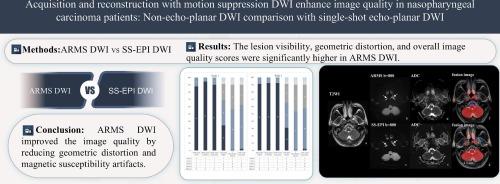Acquisition and reconstruction with motion suppression DWI enhance image quality in nasopharyngeal carcinoma patients: Non-echo-planar DWI comparison with single-shot echo-planar DWI
IF 3.2
3区 医学
Q1 RADIOLOGY, NUCLEAR MEDICINE & MEDICAL IMAGING
引用次数: 0
Abstract
Purpose
To evaluate the impact of application acquisition and reconstruction with motion suppression (ARMS) technology on improving the image quality of diffusion-weighted Imaging (DWI) for nasopharyngeal carcinoma (NPC), compared to single-shot echo-planar imaging (SS-EPI).
Methods
A total of 90 patients with NPC underwent MR examination, including ARMS DWI and SS-EPI DWI sequences. Both DWI sequences were acquired with b-values 0 and 800 s/mm2. Two radiologists evaluated the visibility of the lesion, geometric distortion, and overall image quality of the two DWI sequences. Signal-to-noise ratio (SNR), contrast-to-noise ratio (CNR), geometric distortion degree, and apparent diffusion coefficient (ADC) values of the nasopharyngeal lesions were assessed and compared for two sequences. The Wilcoxon signed-rank test was used to compare the quantitative and qualitative parameters of the two sequences.
Results
The lesion visibility, geometric distortion, and overall image quality scores were significantly higher in ARMS DWI (all P<0.001). Four small-sized lesions were not visible and four lesions were partially visible in the SS-EPI DWI sequence. Lesion detection rate of ARMS DWI is 100 %, while that of SS-EPI is 95.56 %, P<0.043. The mismatch distance between the fusion images of ARMS DWI and T2WI was smaller than that of SS-EPI DWI and T2WI (all P<0.001). The SNR and CNR of ARMS DWI were lower than that of SS-EPI DWI (114.48 ± 37.89 vs. 202.61 ± 78.84, P<0.001 and 1.81 ± 1.84 vs. 3.29 ± 3.71, P<0.003) while the ADC value was higher (839.19 ± 138.44 × 10−6 mm2/s vs. 788.82 ± 110.96 × 10−6 mm2/s, P<0.002).
Conclusion
ARMS DWI improves the image quality by reducing geometric distortion and magnetic susceptibility artifacts. ARMS DWI is superior to SS-EPI DWI for diagnosing small-sized nasopharyngeal lesions, although it has lower SNR and CNR.

用运动抑制 DWI 进行采集和重建可提高鼻咽癌患者的图像质量:非回声平面 DWI 与单次回声平面 DWI 的比较
目的与单次回声平面成像(SS-EPI)相比,评估应用运动抑制采集和重建(ARMS)技术对提高鼻咽癌(NPC)弥散加权成像(DWI)图像质量的影响。两种 DWI 序列的 b 值分别为 0 和 800 s/mm2。两名放射科医生对病变的可见度、几何失真以及两个 DWI 序列的整体图像质量进行了评估。评估并比较了两种序列的信噪比(SNR)、对比度-信噪比(CNR)、几何失真度和鼻咽病变的表观弥散系数(ADC)值。结果 ARMS DWI 的病变可见度、几何失真度和总体图像质量评分明显更高(均为 P<0.001)。在 SS-EPI DWI 序列中,4 个小病灶不可见,4 个病灶部分可见。ARMS DWI 的病灶检出率为 100%,而 SS-EPI 为 95.56%,P<0.043。ARMS DWI 与 T2WI 融合图像的不匹配距离小于 SS-EPI DWI 与 T2WI 融合图像的不匹配距离(均为 P<0.001)。ARMS DWI 的 SNR 和 CNR 低于 SS-EPI DWI(114.48 ± 37.89 vs. 202.61 ± 78.84,P<0.001 和 1.81 ± 1.84 vs. 3.29 ± 3.71,P<0.003),而 ADC 值却高于 SS-EPI DWI(839.19±138.44×10-6mm2/s对788.82±110.96×10-6mm2/s,P<0.002)。结论ARMS DWI通过减少几何失真和磁感应伪影提高了图像质量。ARMS DWI 在诊断小尺寸鼻咽病变方面优于 SS-EPI DWI,尽管其信噪比和 CNR 较低。
本文章由计算机程序翻译,如有差异,请以英文原文为准。
求助全文
约1分钟内获得全文
求助全文
来源期刊
CiteScore
6.70
自引率
3.00%
发文量
398
审稿时长
42 days
期刊介绍:
European Journal of Radiology is an international journal which aims to communicate to its readers, state-of-the-art information on imaging developments in the form of high quality original research articles and timely reviews on current developments in the field.
Its audience includes clinicians at all levels of training including radiology trainees, newly qualified imaging specialists and the experienced radiologist. Its aim is to inform efficient, appropriate and evidence-based imaging practice to the benefit of patients worldwide.

 求助内容:
求助内容: 应助结果提醒方式:
应助结果提醒方式:


